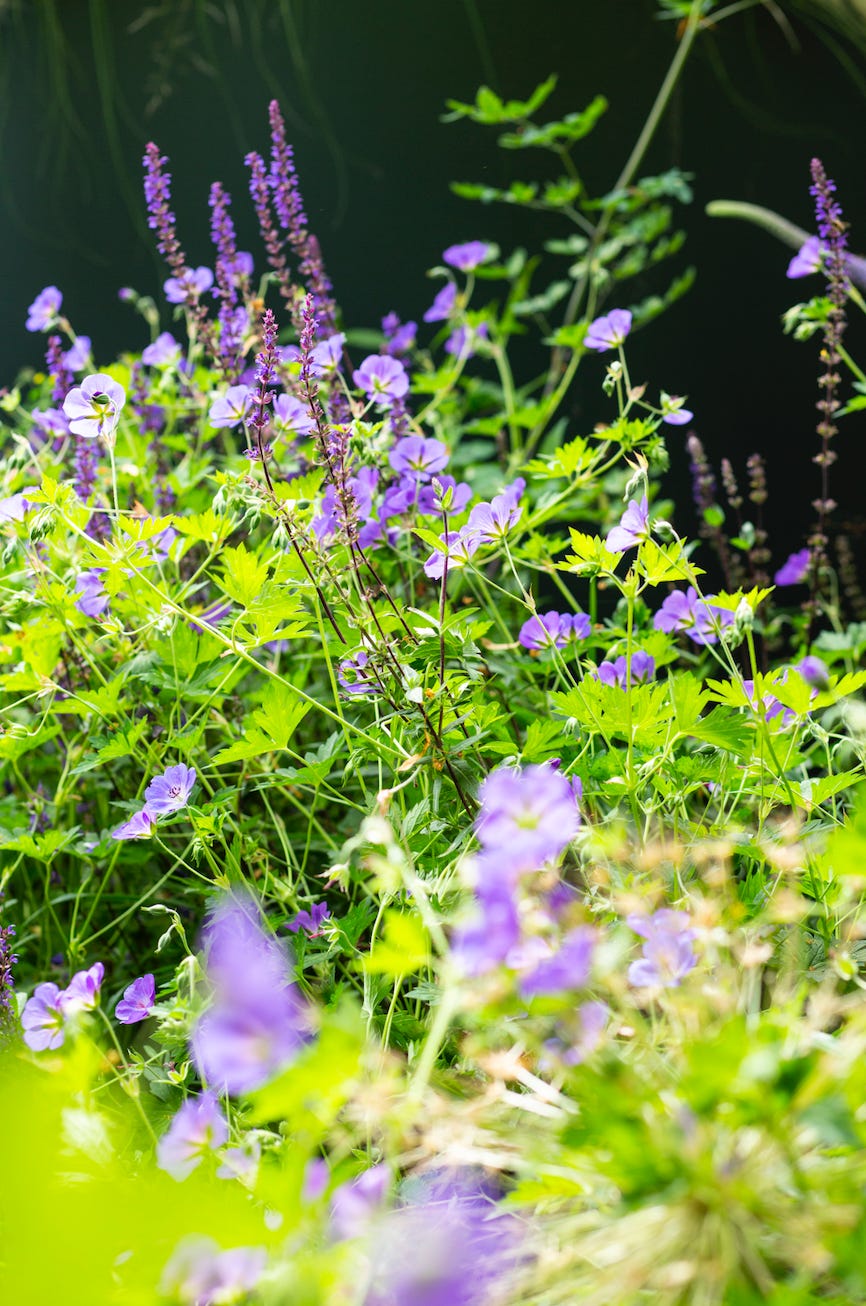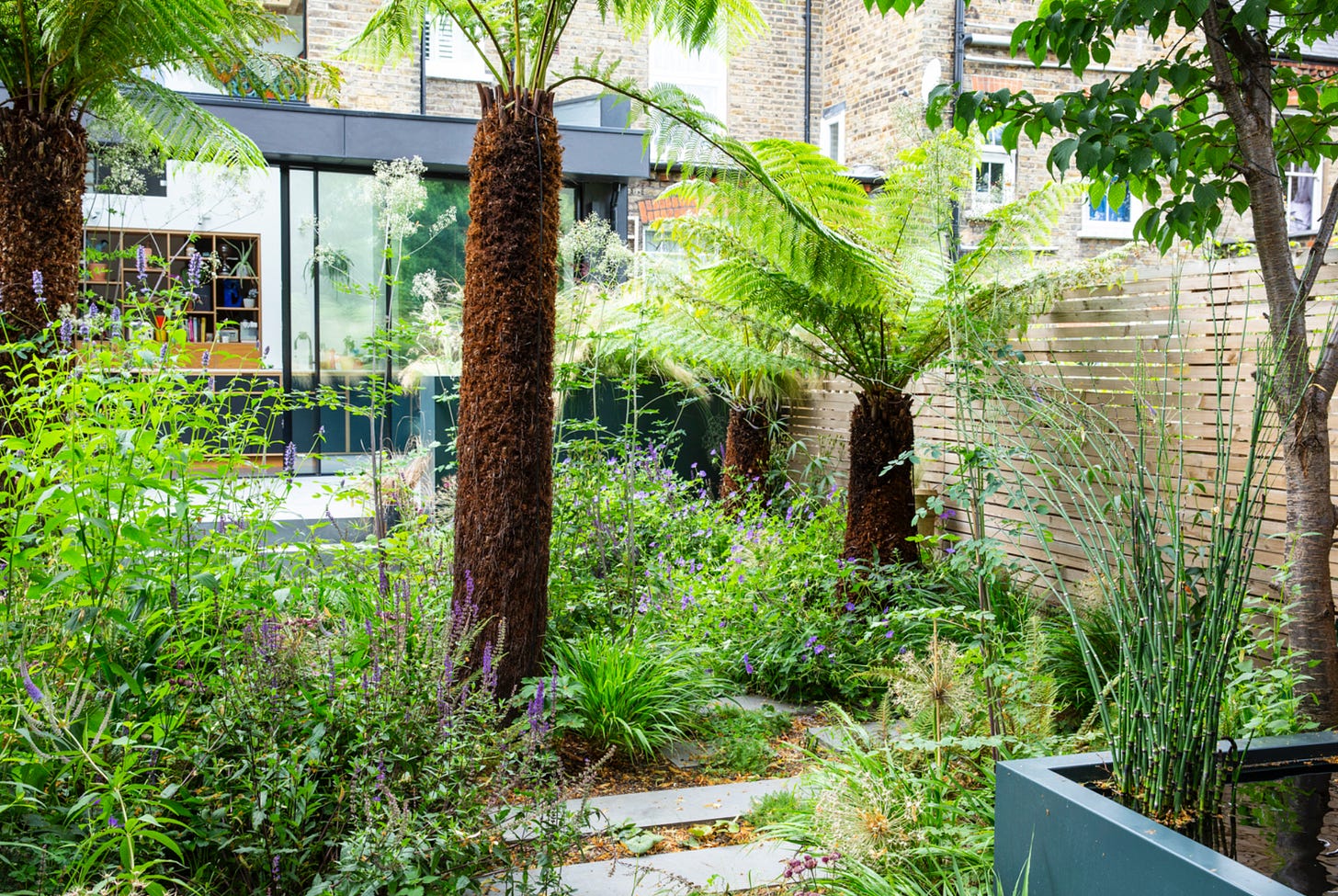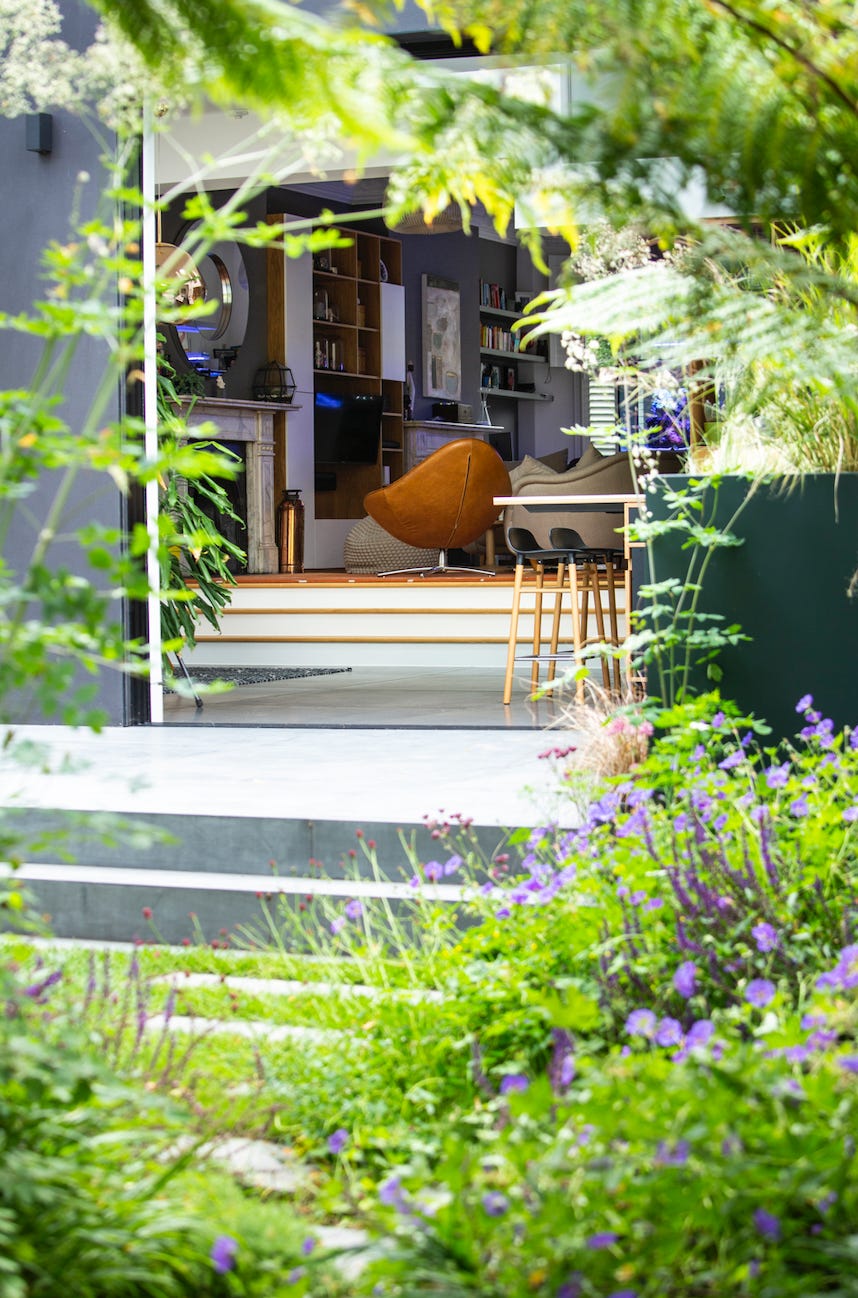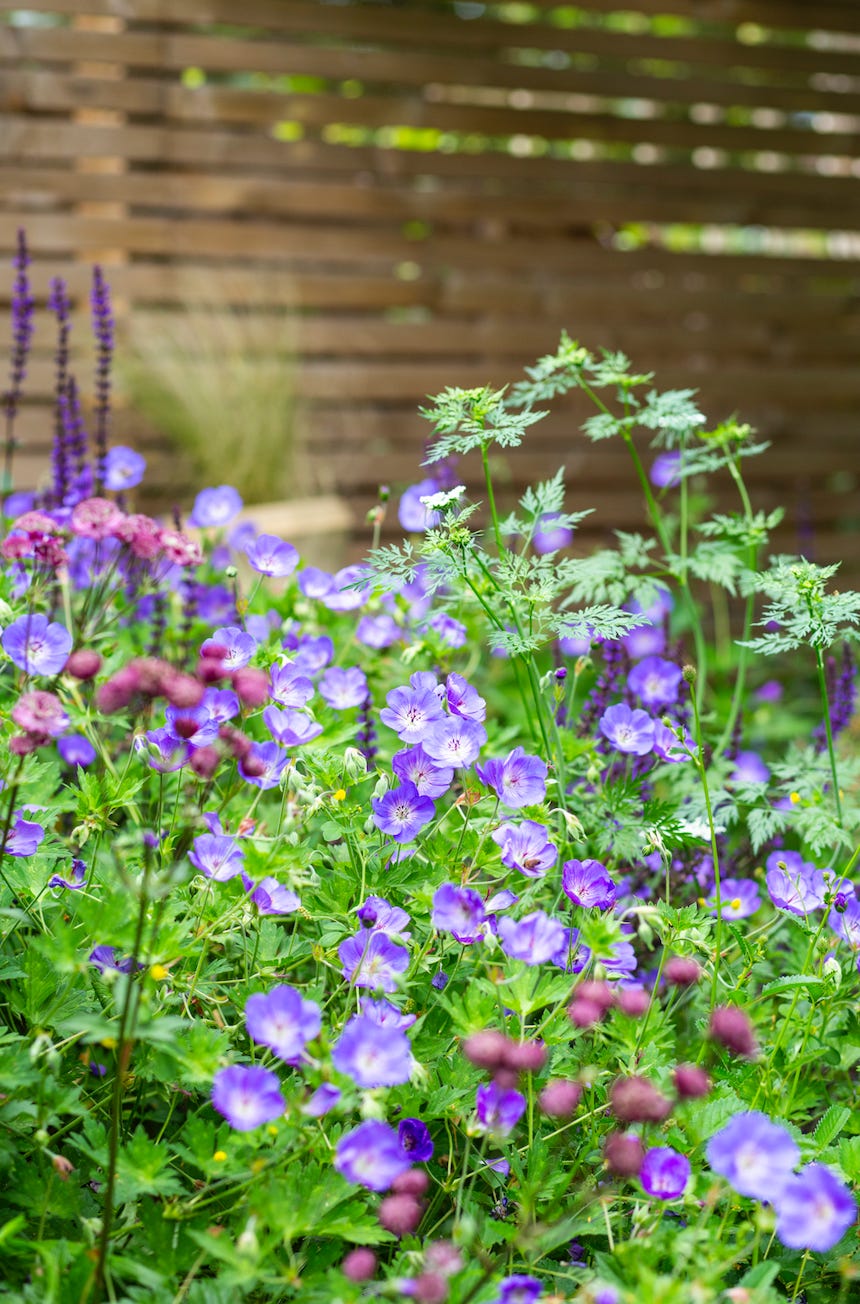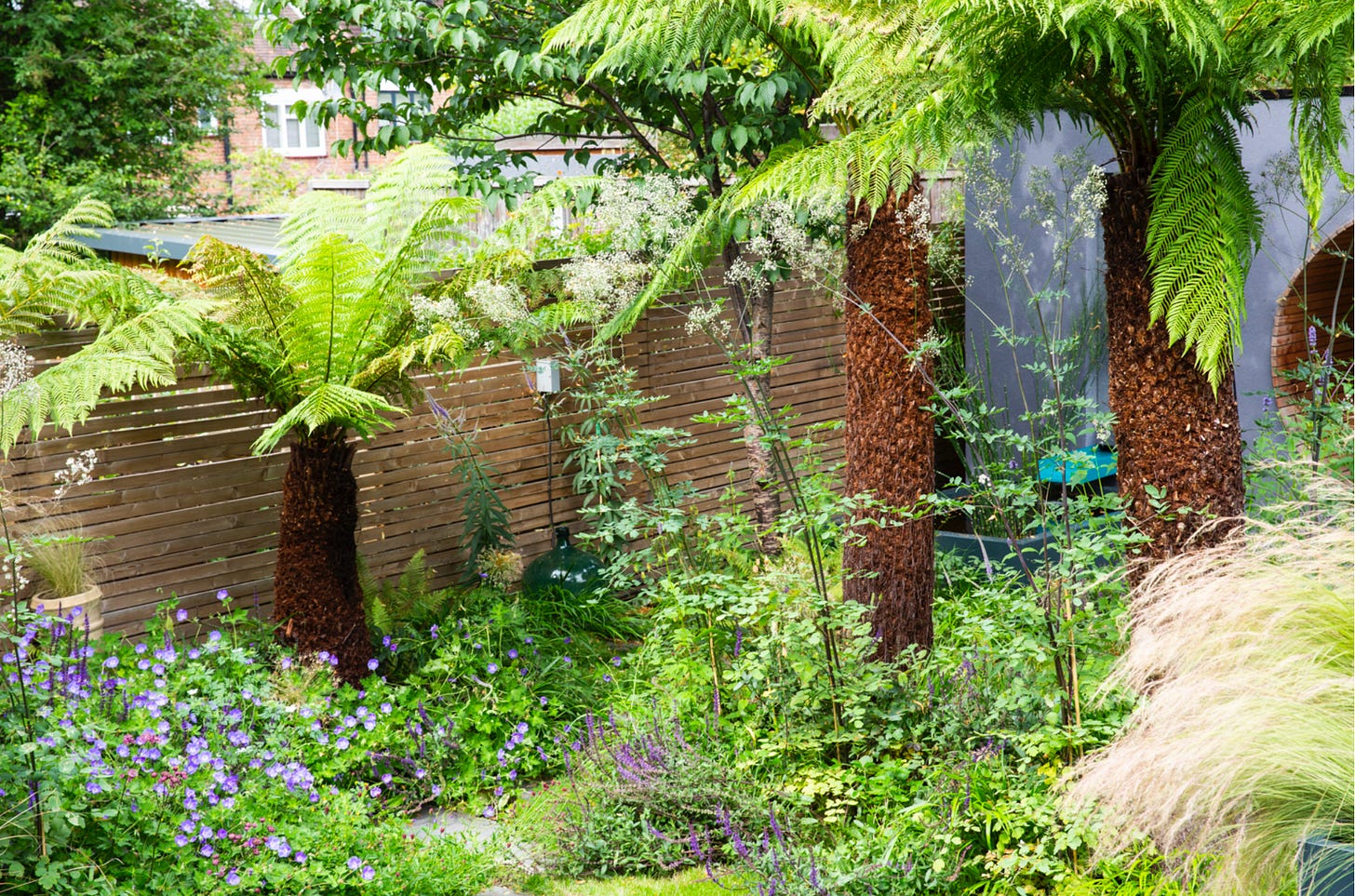What do you do when you have impossible garden neighbours? And a planting recipe
Creating a garden design in the most unromantic of gardens
An easy planting recipe to plan right now - on a cold February day, I recommend sitting down with a cup of tea and a notebook, and this:
It feels like the right time to start choosing plants for the garden beds and borders. To underline that it isn’t the right time to actually get plants in the ground just yet - certainly not here in the UK at any rate. It’s way too cold. Would you go outside in bare feet just yet? Probably not, and if you wouldn’t do that, then it doesn’t seem very fair to plunge the roots of a newly-bought plant into cold, hard, unrelenting soil.
However, it’s definitely the right time to start pondering.
This week, we’re going to take a look at the planting ingredients for a plan for a small city garden. I know you love a plant recipe, and this one is simple, with easy-to-get-hold-of plants which will work in a tiny space as well as a larger one.
And, CRUCIALLY, there are photos of what these plants will look like when they are all grown together. I’d just say right now, if you see a collection of plants on a website or in a book that doesn’t then have a photo of what these plants will actually look like altogether in real life, then just beware a tiny bit. I grow all these plants and put them together, so I can vouch for whether they’ll work or not, whereas I can honestly say that many other ‘places’ just shove a whole lot of photos together. I’ve seen a ‘planting design’ just this week with plant photos and drawings but no photo of WHAT IT WILL LOOK LIKE that almost made me cry because I know it won’t work but you might not know that it won’t work, and that’s what makes me sad. I’m not one to grumble, you know that, but when I see this going on, I have an urge to speak out that makes me almost want to explode with outrage on your behalf. Just saying.
Before we start, a very quick thank you to EVERYONE who has ordered The New Romantic Garden - some of you have already received yours and I can’t wait to hear your thoughts. You can find more book news and new book launch dates in the PS section below.
Thank you for supporting The Gardening Mind. For over three years now, you have made it what it is, and each time you like a post by pressing the ❤️, it means that the word spreads. I’m really grateful: as the word spreads, The Gardening Mind reaches a new audience, many of whom are just dipping a toe into the world of gardening for the very first time.
What do you do when you have impossible neighbours?
Do you have neighbours who have done something unspeakable in their gardens?
If you’re following the Small Garden Design course, you’ll recognise this garden. First appearances suggest it’s very different to many of the gardens I make, but look a bit more closely and you’ll see the same ingredients are there. There’s unkemptness if that’s a word, there’s a relaxed feel. There are easy ground cover plants and easy vertical plants for that all-important veil. There are no roses, shock horror, and instead there’s another surprising yet city-accurate structural plant which creates the atmosphere in this garden which, because of the MOST IMPOSSIBLE of neighbours, had to be transported to a far-away place in the imagination.
I’m hoping you’ll see how this design works for the family I describe here, and also how you could use some of the ideas. The contemporary elements may not be the style for you, but in a place where there are no points of reference in terms of design, and with the need to screen, the points of reference are the people who live there. If you have tricky boundaries and tricky elements you need to somehow get rid of, have a mull over the principles described here. You might find inspiration.
The family of creatives who live here have plenty of imagination, and it’s a good thing. Right in the middle of London, this small city garden is hemmed in not only by buildings, but by neighbours who installed questionable structures that impinged on the family’s own sightlines.
Do you have neighbours who have done something unspeakable in their gardens?
Massive, overgrown trees?
Ugly play structures?
Nasty fencing?
Here, fox-phobic neighbours at the end of the garden had put up 12-foot-high fences, and another neighbour’s play structure capped by architecturally hideous turrets and towers was in constant peripheral view. It was awful. I can’t tell you quite how awful. (Actually I can - there’s a ‘before’ photo later on.) But there was no point making long-term enemies on both sides by fussing over boundary height restrictions, and there was certainly no ‘borrowing’ any beautiful features from the landscape beyond the garden. The only option was to turn all the focus inwards.
If a garden is densely planted and full of interest on the interior, it does paradoxically mean you can get away with including things that might normally look slightly out of place against a grey UK cityscape, so long as the visitors agree collectively to suspend judgment.
Romance, magic and escaping it from it all
Romance. Let’s think of what we, as children, romanticised. Blousy white roses might not resonate much beyond Alice in Wonderland scenarios, but prehistoric jungles? Certainly. Ask any child, and they can probably rattle off a list of at least twenty dinosaur species in as many seconds; these creatures capture children’s imaginations like almost no other. The parents here recognized that with four growing youngsters, everyone had demands on their personal space, and so any way to carve out privacy, an area one could claim as one’s own for even a short while, would go far towards enhancing family harmony.
And if it took a Jurassic theme to achieve more precious moments where everyone wasn’t on top of each other, well, they were willing.
With a can-do approach, we worked together to carve out niches for play, work, reading, gardening, storage, water, dining, and entertaining. I took the cramped area available and celebrated the fact we were doubling down on creating captivating views within. Making a positive out of a negative, looking at what this range of busy people aged five to fifty wanted and needed, in a space with seemingly little space to offer. This family bursts with ideas, life, and energy. They gathered together wishes and hopes, compartmentalised as mental lists, then shared them with me one by one, hoping I could turn them into a cohesive whole.
What emerged is a garden with plenty of geometry and functions that overlap, a garden that doesn’t say ‘romantic’ in the sense that many of the other gardens I design, but a garden which is borne of imagination and a garden which nurtures that imagination, wherever it decides to take you.
A circular focal point, for example, is also a seat which is also a play space within a space also provides shelter and storage. The summerhouse at the end of the garden picks up elements of the house’s interior for consistency that reads as a smooth interpretation of indoor-outdoor living.
The garden is in shade for most of the day due to exterior factors and the built environment, so I focused on using plenty of shade plants to keep it lushly leafy and green. Friendly-looking tree ferns sprout surprisingly at intervals, and hidey-holes are key, letting you run away with your imagination if not from Central London, but definitely allowing you to convince yourself you’re far away from the city, back in time even. When the brave adventurer finally makes their way to the far end of the jungle, they’re rewarded with a retreat for writing and creating and playing and sitting and eating too.
Gardens are for people
So said Thomas Church, who was one of the first designers to really make a case for considering the garden as extension of the house. Focusing on the personality and practical needs of his clients, rather than his own interpretations what placemaking should involve, his legacy serves as a reminder that the designer is there to listen, to advise, to understand, explore and suggest. If these clients asked for fun, it was my job to give them fun.
To that, I’d add that of course gardens are for wildlife too. There is mown grass here for games, but also grass left long. Undisturbed spots behind the built structure are sanctified as habitats for visiting hedgehogs. Water spills down a bright blue spout into a tank, saved for dry days. Ideas, animals, and people can all work together and alongside each other to make a garden at once able to accommodate rowdy movement and quiet solitude.
The accepted opinion in small gardens is to keep things simple: to have not too much of anything and to choose only a few varieties. I absolutely wanted to avoid introducing any more shade into this already-dark garden; the space is small, and so any distraction of colours was going to be too much. So how to create the laid-back atmosphere that the clients so wanted?
It was going to be all about choosing the right plants
Before I share the planting recipe, let’s look at The Awful Before. I think you’ll agree with me on the dire, depressing state:





